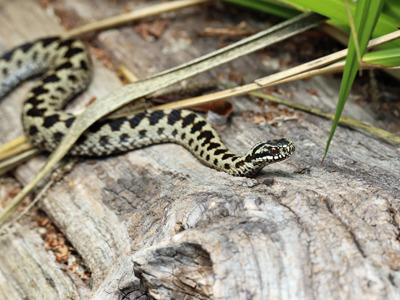
Adder
Vipera berus
A relatively thick-bodied snake, adult adders reach a length of around 60cm. Being a type of viper, this snake has a broad, angular head, with large eyes. The sexes differ physically; females are larger and brown in colour, whereas males have a grey tone.
Both sexes have dorsal zig-zag pattern down their entire length, and a distinctive “V” or “X” on the back of the head. Melanistic (all black) forms are also known, and these are often female.
Behaviour
Diurnal and ovoviviparous (meaning they give birth to live young once they have developed in eggs inside the females). Adders hibernate during the winter months (October to February). The UK’s only venomous snake, they are not naturally aggressive. Due to this bites are rare and are not highly dangerous.
UK Status
Found throughout the UK, but has a patchy distribution (not on Scottish Islands or Ireland). Populations have been declining for the last century and have become locally extinct in some areas.
Due to their static lifestyle, declines in numbers can leave some populations very isolated. Adders are fully protected in the UK under the Wildlife and Countryside Act 1981; it is illegal to injure, kill or sell them.
They are also listed as a Biodiversity Action Plan species (BAP); a status that offers protection and conservation plans in order to halt or reverse their decline.
Threats
Due to their reliance on specific habitat patches, and their lack of mobility through a landscape, they are very sensitive to change and easily lost within an area. Habitat loss and degradation are unsurprisingly a major cause of decline, through changes in landscape and habitat management (e.g. damage to winter hibernation sites). Persecution from game keepers as a method of predator control has historically also been a big threat to adder populations.

Distribution
Can be found across mainland Europe, as well as parts of Asia such as China, and North Korea. It is found further north than any other snake species.
Habitat
Habitat variation is crucial for this species to complement its variable behaviours. Chalky downs, rocky hillsides, woodland edges, meadows, rough commons, heathlands and coastal dunes are all habitat types known to be inhabited by adders.
Diet
Small mammals such as rats, mice and voles make up the majority of their diet. Slow worms, lizards, amphibians and even weasels are also taken, although less common. Juveniles will also eat invertebrates such as worms and spiders.
Wildwood inside information
The best time to see adders, both at Wildwood and out in the field is on a warm day in March or April. This is when adders are waking up from hibernation. If you’re lucky you may see them basking on a rock or log in their enclosure.
Family facts
Adders are venomous but not aggressive. Human deaths from adder bites are extremely rare. There have been no reported deaths from adders bites in the UK since 1975.



